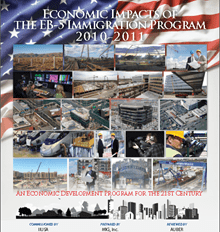In collaboration with economic impact analysis company IMPLAN Group LLC., IIUSA is pleased to present the Economic Impacts of the EB-5 Immigration Program 2010-2011 Report, which highlights benificial economic impacts of the EB-5 Program. This report is an important tool in our advocacy efforts in Washington DC. The primary analyst working on the publication, David Kay of Minnesota IMPLAN Group, presented the findings of his economic analysis at IIUSA’s 3rd Annual International Investment and Economic Develpment Forum in Las Vegas this past June. Below is a reprinting of the Executive Summary of the Report – the publication in it’s entirety is for sale at IIUSA’s online marketplace – click on the link below to be routed to the purchase page. Mr. Kay’s Powerpoint presentation is also available for free at the link below.
EXECUTIVE SUMMARY
Economic Impacts of EB-5 Spending
According to our estimates, spending associated with EB-5 investors contributed $2.65 billion to U.S. GDP and supported over 33,000 U.S. jobs during 2010-2011. The results can be interpreted as a 2-year national impact for all EB-5 spending, including investments, households, and other immigration expenses. Spending by EB-5 investors also contributed $347 million to federal tax revenues and $218 million to state and localtax revenues. These results are totals that include direct, indirect and induced effects (see Table 11). Table 12 shows the top-10 industries impacted by EB-5 spending. Given our estimate of $868 million in construction spending during 2010-2011, it’s not surprising that commercial construction tops the list at
8,106 jobs supported.
A simple average of the 2-year impact shows that EB-5 spending supports over 16,000 U.S. jobs each
year and contributes $1.3 billion to U.S. GDP. Likewise, investor spending adds $173 million in federal
tax revenue annually and $109 million in state and local tax revenue (see Table 22). This is clearly a
much larger impact than originally estimated by the 2010USCIS report, and is primarily due to an
increase in the number of investors participating in the program (see Table 23-24).
Economic Impact Projections
In addition to estimating impacts for 2010-2011, we also scaled up our results to show what impacts may look like if the current visa limit is reached (10,000) or increased (20,000). Table 22 and the following two charts show our results.
If current regulatory and economic environments remain unchanged, economic impact results would increase almost 2.5 times at the 10,000 visa cap. In this scenario, EB-5 spending would support over 83,000 U.S. jobs and contribute $6.6 billion to U.S. GDP. Federal tax revenues would increase to $863 million and state & local tax revenues would increase to $544 million. At the 20,000 visa cap impact results would increase almost 5-fold from current levels. EB-5 spending would then support over 166,000 U.S. jobs and contribute 13.2 billion to GDP. Federal tax revenue would increase to $1.7 billion and state & local tax revenue would increase to $1.1 billion.
Projected Impacts for Jobs and GDP
Study Results for 2010-2011:
Jobs Supported: 33,000 jobs
Contribution to GDP: $2.7 billion
If all 10,000 Visas Cap Used (and 526 demand the same) Visa Cap:
Jobs Supported: 83,000 jobs
Contribution to GDP: $6.6 billion
With a 20,000 Visa Cap (and 526 demand the same) Visa Cap:
Jobs Supported: 166,000 jobs
Contribution to GDP: $13.2 billion








